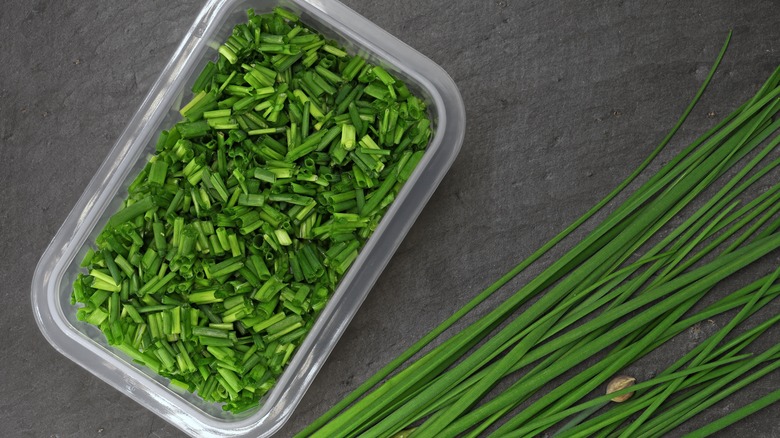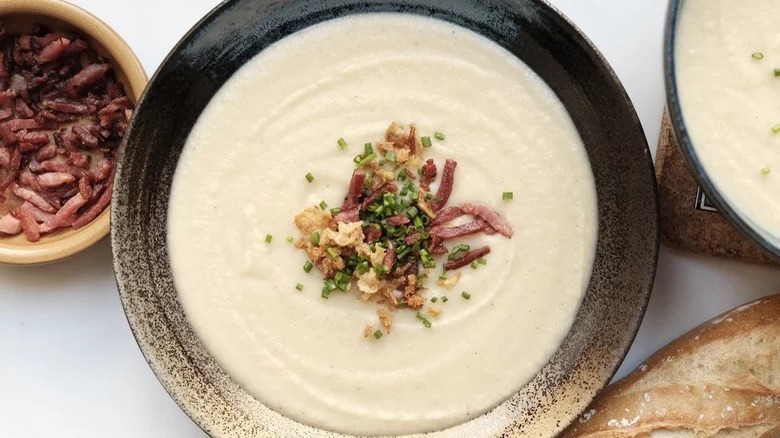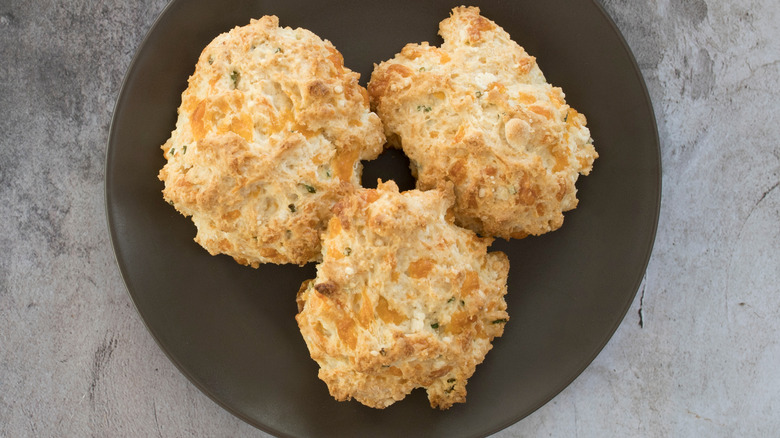14 Best Ways To Use Chives
We may receive a commission on purchases made from links.
Chives provide a versatile, oniony and earthy kick to a variety of foods — no dreaded onion breath included. The herb, which has been cultivated in Europe since the middle ages, and has been used in China for over 4,000 years (via Wisconsin Horticulture), will add a gentle hint of garlicky spice to your plate as well as a boost to your nutritional intake.
According to WebMD, this member of the allium family (which also includes garlic, onions, and leeks) boasts a whole list of health benefits and is linked to preventing cancer and osteoporosis due to its Vitamin K compounds. Some studies show chives can even improve your memory and sleep. Just a sprinkle as a garnish over one of your favorite meals is enough to pack a nutritious and flavorful punch. So with no reason not to give this versatile herb a try, here are some of the best ways to make the most out of chives.
Melt chive butter over your favorite protein
It's no surprise that chive butter is one of the most popular ways to incorporate the herb. Chives add a layer of decadence as well as a depth of flavor to butter, making a delicious addition to anything from steak, fish, potatoes, or roasted vegetables. You can use an electric mixer or even a good old-fashioned fork and mixing bowl, but make sure to allow the butter to soften first to make the process easier.
While a simple chive butter recipe will only take five minutes to make, if you're looking to step your chive butter up a notch, try this bone marrow butter with chives and Meyer lemon recipe. By whipping the marrow into the butter along with a touch of citrus for brightness and other seasonings including parsley, shallots, sea salt, and red pepper flakes you'll be left with a rich compound butter with a boosted complexity of flavor. The varieties are truly endless, so don't be afraid to experiment with different flavor combinations by adding other herbs, garlic, or seasonings such as cayenne for a bit of spice.
Take garlic bread to the next level
Make chive butter the true star of the show by enhancing it even more with the addition of garlic, parmesan, basil, and parsley, and generously spread overtop a sliced baguette for an herby and toasty garlic bread. According to The Washington Post, garlic bread originated from Italian bruschetta alla romana, which was toasted bread rubbed with garlic. While its initial version included olive oil drizzled over top, butter was substituted when Italian immigrants arrived in the United States due to a lack of olive oil available.
The modern version of garlic bread was thus born, and by the 1940s, had become widely popular in Italian restaurants. Garlic bread is typically served with pastas, soups or salads, but it can become a welcome addition to nearly any entrée. If you're looking for a less traditional take on this Italian-American favorite, take a cue from TikTok sensation Cedric Thomas and substitute a classic loaf for tangzhong, or Japanese milk bread, for a contrasting sweet and salty flavor. Consider following his unconventional garlic bread technique which involves heating up compound butter-slathered bread in a pan rather than an oven.
Perk up your salads and marinades with chive blossom vinegar
Although chives are more commonly associated with their long, green stems, their lavender flowers are also edible and make a versatile addition to plenty of foods, according to Miriam Jacobs, author of "Cooking With Edible Flowers." While chive blossoms still offer an onion-like flavor, they are milder than the stems. For a salad dressing that has a delicate but distinctive bite, look no further than chive blossom vinegar — simply pour vinegar over the blossoms (make sure to wash them first) and allow it to steep for at least three days.
Any unused blossoms can even be added on their own into the salad, enhancing its flavor, amping up the nutritional value, and adding a lovely purple color. The vinegar can also be integrated into sauces and marinades. You can even use the vinegar as a shrub to add a tangy flavor to your liquor. Find the blossoms at your local farmer's market or try growing the herb yourself; they grow easily in the sun and are best planted in early spring (via Almanac).
Satisfy your fried food craving with Korean chive pancakes
Korean chive pancakes are a staple of Korean cuisine for a reason. These crispy, savory discs, also known as buchujeon ("buchu" means "garlic chives" and "jeon" is pancake"), studded with an assortment of ingredients including prawns, vegetables, and you guessed it, chives, are sure to make a delectably-fried appetizer or snack. Don't be stingy with the chives — there should be enough that the batter is just coating them. Korean chives are best, but if those aren't available, Chinese chives, also known as garlic chives, will also work well.
Just make sure to include a dipping sauce — anything as simple as a mixture of equal parts soy sauce, rice vinegar, and water, plus a bit of sugar, will add a satisfying balance to your Korean chive pancakes. If you're looking to spruce it up some more, the addition of finely chopped green onions, sesame seeds, or some chili pepper for heat will enhance your sauce further.
Brighten up breakfast by garnishing eggs
It's no secret that experts consider eggs to be nature's multivitamin due to their high quantity of vitamins, minerals, and protein (via Healthline). But just because eggs have been a breakfast staple throughout the world for generations doesn't mean they need to be boring. Level up any egg dish with a gourmet touch by sprinkling chives on top. Keep things simple with fluffy scrambled eggs topped with herbs or try this decadent and delicious eggs benedict with salmon recipe for your next Sunday brunch. While a classic eggs benedict utilizes ham, smoked salmon adds a fun and heart-healthy twist, pairing excellently with the crisp flavor of chives. Consider it a more decadent version of the familiar bagel, lox, and cream cheese trio.
No matter which recipe you decide to start your day with, don't be afraid to generously season your eggs, and feel free to add other herbs such as parsley or tarragon as well. Add a side of seasonal fruit or chive-topped breakfast potatoes for a complete meal.
Add an herbal touch to potatoes
"The potato is like a painter's empty canvas, and can absorb it all," cookbook author and chef Raghavan Iyer told Detroit News, and while potatoes are adaptable enough to pair with nearly any herb, chives and potatoes go together like coffee and cream. While there's nothing wrong with the standard combo of sour cream, melted cheese, and chives over potatoes, switch things up with this luxurious aioli mashed potatoes recipe with chives that is sure to make your mouth water.
Unlike many standard mashed potato recipes weighed down with copious amounts of dairy, this recipe's use of garlicky aioli provides an equally rich and creamy result. Similarly to with your eggs, don't be afraid of overseasoning — potatoes love salt, notes recipe creator Andy Baraghani. The recipe will yield about six servings that will complete any steak, salmon, or turkey entrée. Even if you opt for a less decadent potato dish, chives will spruce up anything from simple breakfast potatoes to lemony roasted potatoes.
Jazz up steak with crispy, dehydrated chives
Speaking of steak, rosemary, thyme, and oregano may be the most common herbs used to elevate your dish, but for a savory kick with a hint of spice, try adding a sprinkle of dehydrated chives overtop your favorite steak recipe. While fresh chives will of course work, you can also opt for a dehydrated variety.
Fresh chives last in your fridge for up to two weeks, but did you know that dehydrated chives will keep for as long as three years? There are multiple methods you can use to prepare dehydrated chives: Either pop a bunch of fresh chives in the oven at 100 F for about an hour, or try the old-fashioned method, by hanging them upside down in a warm, dry place (it can take anywhere from eight hours to a week for your chives to fully dry, according to MasterClass). Add your dehydrated chives after the steak has been cooked, as experts recommend only seasoning your steak with salt before cooking.
Garnish nearly any type of seafood
Part of chives' appeal is that they are just so versatile, adding an earthy pop to various types of seafood. Whether served with fish such as cod, tilapia, or salmon or sprinkled into a broth accompanying steamed mussels, chives will add a dash of freshness to nearly any seafood dish. For a meal that is comforting while still feeling light, look no further than a Connecticut-style lobster roll recipe. Chives take this quintessential American sandwich to even greater heights. Combined with a light sprinkling of tarragon and an extra squeeze of lemon, they add another dimension of flavor to an already delightful combination of lemony, herbal, and buttery notes of the roll, according recipe creator Stephanie Rapone.
As an ode to the first-documented lobster roll, created in Connecticut in 1929 (via Culture Trip), this sandwich is a warm and buttery variation, unlike its Maine-style alternative, which is cold and served with a mayonnaise-based dressing. In the 1960s, the lobster roll began to take off, popping up throughout New England, and both styles are extraordinarily popular today.
Elevate your snacking with caramelized onion and shallot dip
Nowadays, chips and dip are considered an iconic American snack food, and are a staple of nearly any casual gathering. Chips and dip started taking hold of American party cuisine in the 1950s, when the famous combo began popularizing due to a change in entertaining styles plus a very successful Lipton's Soup Mix advertising campaign, according to Mark McWilliams' "The Story Behind the Dish."
While a classic sour cream and onion dip consists solely of sour cream or cream cheese and soup mix, try this caramelized onion and shallot dip instead that's fancier than your regular chips-and-dip combo but sure to wow your tastebuds. Its use of a luscious aioli rather than a typical dairy base will leave you feeling satisfied and reaching for more. But there's no shame in just eating this dip by the spoonful— in fact, a recent survey found that 63% of people surveyed enjoy their dips straight from the container, no chips or veggies needed, according to StudyFinds.
Awaken creamy soups and chowders
Chives add a fresh flavor to any hearty soup recipe that's creamy and thick, such as our cauliflower potato soup. Rather than with a brothier soup, chives will work wonderfully with a soup such as this that has a heavier consistency, allowing the herbs to work their magic by adding a much-needed lift. Packed with nutritious roasted veggies such as onions, this rich soup benefits from the addition of chives which compliment the allium layers of flavor while making the dish look more appetizing, thanks to its vibrant green color.
While either fresh or dehydrated chives would suffice, if you're using fresh chives, be sure to add them immediately before serving — chives are so delicate that the heat of the soup will immediately diminish its garlicky flavor. To really make this soup soar, add crispy bacon bits and fried onions overtop. Serve with a side of crusty garlic bread for a complete meal that will be both filling and nourishing at any time of the year.
Whip up a delightfully herbal chimichurri sauce
Chimichurri is a staple of Argentinian cuisine, and is essentially a sauce that looks somewhat similar to an Italian pesto, but offers a more garlicky, grassy kick to your meals, according to BBC. While many Argentinians debate about the origins of chimichurri, most would agree that chives are an untraditional addition. But that shouldn't stop you from including the herb in a fresh chimichurri sauce recipe.
You'll find that chives add a new layer of herbal flavor to this garlic, parsley, chiles, olive oil, and vinegar-based sauce that's amazing on your favorite steak, chicken or potato recipe. While dried oregano will work in this recipe, Ryu notes that all other herbs such as the chives should be fresh. But the beauty of chimichurri is that it's so multi-purposed— switch up the herbs or their quantities depending on your preferences. Just make sure to let the sauce sit for at least 20 minutes before serving, allowing the herbal flavors to really come forth.
Make an herbaceous cocktail
You may have heard of adding pickled onions or cocktail olives to your martini, so why not switch up this classic drink and use chives instead? Martinis are famously simple, generally consisting just of vodka or gin and vermouth, meaning they are ideal for amplifying nuances of flavor. While martinis can be made with either vodka or gin, you'll definitely want to stick with gin for this one — while vodka is typically distilled with grains or potatoes, gin is instead distilled with juniper berries and other botanicals, resulting in a dry taste that allows the earthy and herbal flavors to truly shine (via Britannica).
To create this variation, simply add chive blossoms to your favorite gin, and allow it to infuse at room temperature for anywhere from two hours to an entire day, leaving you with a layered, umami flavor. You'll want to strain out the blossoms after the infusion has completed, but add the blossoms to the top of each cocktail for a bright and aesthetically pleasing touch.
Add chives to dumplings
While European chives are treated more as an herb, the Chinese chive variety acts more as a vegetable and is cooked, according to FoodPrint. With that said, chives are much more than just a garnish, and are a necessary component of this pork and chive dumplings recipe.
Dumplings are a great opportunity to incorporate frozen chives, since frozen chives won't work for a garnish, but are the perfect addition to recipes where they will be cooked. All it takes is finely chopping the chives, and freezing them on a paper towel or parchment-lined baking sheet so that they are spread apart and don't clump. After they're frozen (after about 15 minutes or so), put them in a Ziploc bag and you're good to go! Get Busy Gardening recommends also freezing in an ice tray, just loosely add to each compartment (without overfilling) and add oil or water. They can last in your freezer for several months.
Brighten up biscuits
According to The Washington Post, biscuits originated in England, but soon became a staple of Southern cooking in the United States while utilizing ingredients more plentiful in the American South, such as butter, buttermilk, and wheat. Initially enjoyed as a delicacy, by the 1880s, this scone-like baked good took hold in American food culture.
For another way to utilize those chives you've frozen, freeze-dried chives will add a colorful and vitamin-rich addition to these five-ingredient garlic cheddar biscuits. The chives compliment the sharp cheddar while still allowing the garlicky flavors to shine in these soft and buttery biscuits that only take 20 minutes to make. Top with chive butter to further enhance the onion-y notes, or balance your biscuits out with sweetness by topping them with strawberry jam.
These biscuits will make a welcome addition to nearly any soup or meat dish, or can even be used as a sandwich base. Alternatively, eat them on their own as a snack or for breakfast; much like chives, biscuits are deliciously versatile and can stand either as a savory side or on their own.














